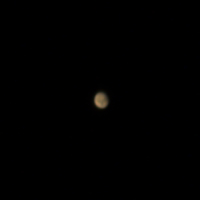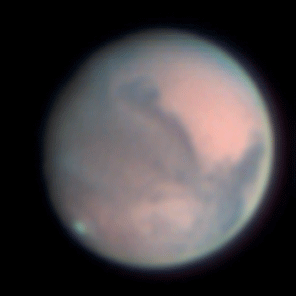Mars is all over the recent news with a fleet of space craft arriving:
-NASA's perseverance pulled off a crazy landing with a supersonic parachute (which just sounds cool), followed by a heat shield, then rockets, and finally a sky crane lowering the lander into the dust with the rocket hovering above. NASA video.
-the UAE's Al'Amal (hope) is orbiting the planet and filming.
-China's Tianwen-1 is orbiting, preparing to send down a lander.
Perseverance is loaded with easter eggs including a binary message encoded in the parachute: "Dare Mighty Things", the motto of NASA’s Jet Propulsion Laboratory (JPL) and the coordinates of the JPL visitor's center: 34°11'58.0"N 118°10'31.0"W.
More easter eggs here
You can even follow the perseverance twitter account:
"Hobbies: Photography, collecting rocks, off-roading" 😄
so here's an excuse to process the rest of my mars opposition images. the following sequence shows the south polar cap slowly melting in the martian summer (though some of the change is due to rotation).
 |
Mars 2020
Click for full size |
Here's a final shot at shorter focal length from the evening of the great conjunction: |
Mars 12/20/2020
wave goodbye |
long winded technical imaging stuff: the right hand image above was captured with a one shot color (OSC) camera. an 850 nm IR filter was used to capture IR frames. how can an IR filter work with a OSC camera? all of the color filters pass IR (this is why you need an IR blocking filter for many OSC cameras). so theoretically a relatively long IR filter will pass IR to all color pixels giving a mono IR image.
unfortunately i didn't realize i needed to uncheck the color balance during acquisition, so the pass-through wasn't uniform by color: it yielded the typical checker board appearance one sees with an undebayered color image. color conversion gave a blue tinted image. each of the "color" images were identical, so a simple color balance gave a mono image. perhaps it was the conditions or the filter, but the debayered IR image offered no improvement in resolution compared to the red filter. which is not my experience with a mono camera, though i've not tested the 850 mono yet.
***will have to try again with the white balance adjusted next season
from a practical stand point IR/OSC images probably don't add much unless there's a major dust storm interfering with surface visibility as in the 2018 opposition.
in a prior post i noted that while using IR as luminance generally improves the contrast/sharpness of the blue surface detail, it loses subtle cloud detail. i note an interesting corollary to that with this image: using IR in place of the red channel will enhance clouds as they appear bluish compared to the background:  |
Mars 11/15/2020 06:17 UTC
IR-G-B |
Image details:
celestron 11" Edge HD
ZWO ASI 290MM
ZWO RGB filters, Baader IR pass "685" nm
30% histogram
firecapture, autostakkert, winjupos, maxim, photoshop
9/29/20 07:35 UTC
2x120 second captures each filter, 400 FPS
gain 351, exposure ~.2 ms,
tried a methane filter for fun which was like a bad IR filter :(
10/11/2020 8:27 UTC
2x120 second captures each filter, 400 FPS
gain 351, exposure ~.2 ms,
10/14/2020 07:48-08:09 UTC
very good seeing
*televue 2x barlow*
2x120 second captures each filter, 200 FPS
gain 351, exposure ~1 ms,
elevation ~60 degrees
11/15/2020 06:17 UTC
ZWO ASI 290MC
ZWO 850 nm IR pass filter
6x120 second captures RGB, 400 FPS
gain 351, exposure ~.2 ms,
Eastbluff
Southern California...


